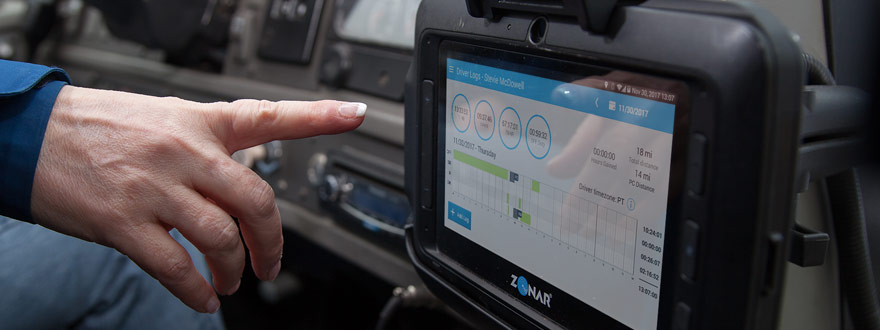Top 6 ELD Exemptions

The ELD rule applies to most motor carriers and drivers currently required to maintain Records of Duty Status (RODS) per Part 395, 49 CFR 395.8(a). The rule applies to commercial buses as well as trucks, and to Canada- and Mexico-domiciled drivers. The final deadline for compliance with the ELD mandate was December 16, 2019. However, some exemptions still exist.
So, who is exempt from the ELD mandate? Below are the top six exemptions.
Vehicles Manufactured Before 2000
An electronic logging device (ELD) unit requires an engine control module (ECM). However, most engines manufactured before 2000 lack an ECM. Therefore, if a commercial motor vehicle’s engine was manufactured in 2000 or earlier, that vehicle is exempt from being required to use an ELD. This exemption previously listed the cutoff year to be for the vehicle. However, it’s the engine that counts, and engines can be swapped. This exemption now applies to the engine’s model year, regardless of the vehicle’s registration date. Vehicles with engine models in 2000 or later require ELDs, even if the vehicle itself was manufactured before 2000. Learn more: The Pre-2000 Model Year Exemption Applies to Engines, Not the VINDriveaway-towaway Drivers
Driveaway-towaway drivers delivering a commercial motor vehicle as part of a shipment don’t own the vehicle and therefore are not required to equip it with an ELD.Drivers Who Maintain RODS for 8 Days or Less
Drivers who maintain Record of Duty Status (RODS) for 8 days or fewer in a 30-day rolling period don’t need an ELD. They need to maintain paper logs, but the ELD itself isn’t legally required. This includes short-haul drivers who occasionally take longer trips. However, drivers who break the short-haul exception more than 8 times in a 30-day period will need an ELD for the rest of that cycle. This ELD exemption means that short-haul drivers who make longer trips infrequently don’t have to upgrade.Short-haul Exception
Some commercial drivers license (CDL) drivers fall under the short-haul exemption. These drivers report to work and either transport their loads to a specific location or completes a daily delivery. They then return their truck and go home. Previously known as the 100 Air-mile Radius exception, an updated Final Rule recently published by the FMCSA extends the radius to 150 miles. According to the FMCSA, “Permitting this change increases the number of drivers able to take advantage of the exception and shifts work and drive time from long-to short-haul.” To qualify, drivers must:- Operate within a 150 air-mile radius of their normal work reporting location
- Start and end the day at the same location
- Be released from work within 12 hours
- Have at least 10 hours off duty between each 12-hour shift
- Not drive more than 14 hours
150 Air-mile Radius
Some non-CDL drivers fall under the short-haul exemption, too. To qualify, they must:- Operate within a 150 air-mile radius of the location where they report to and are released from work
- Return to the normal reporting location at the end of each duty tour
- Drive any vehicle that requires a CDL
- Drive after 14 hours of coming on duty on 5 days of any period of 7 consecutive days
- Drive after 16 hours of coming on duty on 2 days of any period of 7 consecutive days
Farm Vehicles
Certain farm vehicles, and the carriers who operate them, are exempt from having to have an ELD. This is not a blanket exemption for all agricultural vehicles and equipment. It applies to the private transport of commodities such as livestock, machinery or supplies being transported by the farm’s owner or operator, or a family member or employee. Learn more: Agricultural commodity per the FMCSAUpdates to the FMCSA’s HoS Final Rule
The FMCSA has published updated its HoS rule based on public feedback, and includes four key revisions to existing regulations form commercial motor vehicle (CMV) drivers. Updated based on public feedback, this rule provides greater flexibility for drivers subject to those rules without adversely affecting their safety. Specifically, the rule:- expands the short-haul exception to 150 air-miles and allows a 14-hour work shift to take place as part of the exception
- expands the driving window during adverse driving conditions by up to an additional 2 hours
- requires a 30-minute break after 8 hours of driving time (instead of on-duty time)
- allows an on-duty/not driving period to qualify as the required break
- modifies the sleeper berth exception to allow a driver to meet the 10-hour minimum off-duty requirement by spending at least 7, rather than at least 8 hours of that period in the berth and a minimum off-duty period of at least 2 hours spent inside or outside of the berth, provided the two periods total at least 10 hours, and that neither qualifying period counts against the 14-hour driving window.





